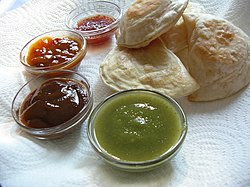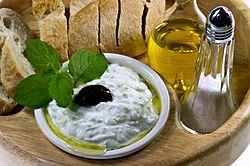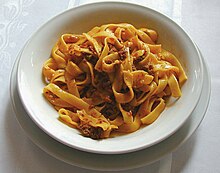

|
Reverted 1 edit by 211.30.200.163 (talk): Rv LTA
|
m Reverted edits by Green yeti (talk) (AV)
|
||
| (7 intermediate revisions by 7 users not shown) | |||
| Line 1: | Line 1: | ||
{{short description|Liquid, cream, or semi-solid food served on or used in preparing other foods}} |
{{short description|Liquid, cream, or semi-solid food served on or used in preparing other foods}} |
||
{{other uses}} |
{{other uses}} |
||
| ⚫ | |||
[[File:Lunch sauces.jpg|thumb|250px|[[Samosa]]s accompanied by four sauces]] |
[[File:Lunch sauces.jpg|thumb|250px|[[Samosa]]s accompanied by four sauces]] |
||
[[File:Tzatziki IMGP1480.jpg|thumb|250px|[[Tzatziki]] yoghurt sauce]] |
[[File:Tzatziki IMGP1480.jpg|thumb|250px|[[Tzatziki]] yoghurt sauce]] |
||
| Line 9: | Line 10: | ||
Sauces need a [[liquid]] component. Sauces are an essential element in cuisines all over the world. |
Sauces need a [[liquid]] component. Sauces are an essential element in cuisines all over the world. |
||
Sauces may be used for sweet or savory dishes. They may be prepared and served cold, like [[mayonnaise]], prepared cold but served lukewarm like [[pesto]], cooked and served warm like [[bechamel]] or cooked and served cold like [[apple sauce]]. They may be freshly prepared by the cook, especially in restaurants, but today many sauces are sold premade and packaged like [[Worcestershire sauce]], [[HP Sauce]], [[soy sauce]] or [[ketchup]]. Sauces for [[salad]] are called [[salad dressing]]. Sauces made by [[Deglazing (cooking)|deglazing]] a pan are called pan sauces. |
Sauces may be used for sweet or savory dishes. They may be prepared and served cold, like [[mayonnaise]], prepared cold but served lukewarm like [[pesto]], cooked and served warm like [[bechamel]] or cooked and served cold like [[apple sauce]]. They may be freshly prepared by the cook, especially in restaurants, but today many sauces are sold premade and packaged like [[Worcestershire sauce]], [[HP Sauce]], [[soy sauce]] or [[ketchup]]. Sauces for [[salad]] are called [[salad dressing]]. Sauces made by [[Deglazing (cooking)|deglazing]] a pan are called pan sauces. |
||
A chef who specializes in making sauces is called a [[saucier]]. |
A chef who specializes in making sauces is called a [[saucier]]. |
||
| Line 41: | Line 42: | ||
Sauces in [[Cuisine of France|French cuisine]] date back to the Middle Ages. There were many hundreds of sauces in the culinary repertoire. In ''[[cuisine classique]]'' (roughly from the end of the 19th century until the advent of ''[[nouvelle cuisine]]'' in the 1980s), sauces were a major defining characteristic of French cuisine. |
Sauces in [[Cuisine of France|French cuisine]] date back to the Middle Ages. There were many hundreds of sauces in the culinary repertoire. In ''[[cuisine classique]]'' (roughly from the end of the 19th century until the advent of ''[[nouvelle cuisine]]'' in the 1980s), sauces were a major defining characteristic of French cuisine. |
||
In the early 19th century, the chef [[Marie-Antoine Carême]] created an extensive list of sauces, many of which were original recipes. It is unknown how many sauces Carême is responsible for, but it is estimated to be in the hundreds. Most of them have been listed in Carême reference cookbook "The art of French Cuisine in the 19th century" (The French Title: "L'art de la cuisine française au XIXe siècle").<ref>{{Cite book|last=Carême|first=Marie-Antoine (1784-1833) Auteur du texte|url=https://gallica.bnf.fr/ark:/12148/bpt6k853460z|title=L'art de la cuisine française au XIXe siècle : traité élémentaire et pratique,.... T. 2 / par M. A. Carême,...|date=1833 |
In the early 19th century, the chef [[Marie-Antoine Carême]] created an extensive list of sauces, many of which were original recipes. It is unknown how many sauces Carême is responsible for, but it is estimated to be in the hundreds. Most of them have been listed in Carême reference cookbook "The art of French Cuisine in the 19th century" (The French Title: "L'art de la cuisine française au XIXe siècle").<ref>{{Cite book|last=Carême|first=Marie-Antoine (1784-1833) Auteur du texte|url=https://gallica.bnf.fr/ark:/12148/bpt6k853460z|title=L'art de la cuisine française au XIXe siècle : traité élémentaire et pratique,.... T. 2 / par M. A. Carême,...|date=1833}}</ref> |
||
Carême considered the four ''grandes sauces'' to be [[Espagnole sauce|Espagnole]], [[Velouté sauce|Velouté]], [[Allemande sauce|Allemande]], and [[Sauce Béchamel|Béchamel]], from which a large variety of petites sauces could be composed.<ref name="Carême1854"> |
Carême considered the four ''grandes sauces'' to be [[Espagnole sauce|Espagnole]], [[Velouté sauce|Velouté]], [[Allemande sauce|Allemande]], and [[Sauce Béchamel|Béchamel]], from which a large variety of petites sauces could be composed.<ref name="Carême1854"> |
||
| Line 56: | Line 57: | ||
|url=https://babel.hathitrust.org/cgi/pt?id=pst.000061786981&view=1up&seq=64https://babel.hathitrust.org/cgi/pt?id=pst.000061786981&view=1up&seq=33&q1=espagnole%20veloute%20bechamel%20tomato |access-date=17 December 2020 |
|url=https://babel.hathitrust.org/cgi/pt?id=pst.000061786981&view=1up&seq=64https://babel.hathitrust.org/cgi/pt?id=pst.000061786981&view=1up&seq=33&q1=espagnole%20veloute%20bechamel%20tomato |access-date=17 December 2020 |
||
}} |
}} |
||
</ref> |
</ref> Sauce Allemande, which was mentioned as a preparation of Velouté made with egg yolks,<ref name="Escoffier1903"> |
||
{{ |
{{ |
||
cite book|last1=Escoffier|first1=Auguste|author-link=Auguste Escoffier|last2=Gilbert|first2=Philéas|last3=Fétu|first3=E.|last4=Suzanne|first4=A.|last5=Reboul|first5=B.|last6=Dietrich|first6=Ch.|last7=Caillat|first7=A. |
cite book|last1=Escoffier|first1=Auguste|author-link=Auguste Escoffier|last2=Gilbert|first2=Philéas|last3=Fétu|first3=E.|last4=Suzanne|first4=A.|last5=Reboul|first5=B.|last6=Dietrich|first6=Ch.|last7=Caillat|first7=A. |
||
| Line 62: | Line 63: | ||
|url=https://books.google.com/books?id=t8UeTMbS5uYC|access-date=7 December 2013|year=1903 |
|url=https://books.google.com/books?id=t8UeTMbS5uYC|access-date=7 December 2013|year=1903 |
||
|publisher=Émile Colin, Imprimerie de Lagny|language=fr|location=Paris|display-authors=etal|url-status=live |
|publisher=Émile Colin, Imprimerie de Lagny|language=fr|location=Paris|display-authors=etal|url-status=live |
||
|archive-url=https://web.archive.org/web/20140104165512/http://books.google.com/books?id=t8UeTMbS5uYC|archive-date=4 January 2014 |
|archive-url=https://web.archive.org/web/20140104165512/http://books.google.com/books?id=t8UeTMbS5uYC|archive-date=4 January 2014 |
||
}} |
}} |
||
</ref> is replaced by Sauce Tomate.<ref name=escoffier1912> |
</ref> is replaced by Sauce Tomate.<ref name=escoffier1912> |
||
| Line 68: | Line 69: | ||
Cite book|last=Escoffier|first=Auguste (1846-1935) |
Cite book|last=Escoffier|first=Auguste (1846-1935) |
||
|title=Le Guide Culinaire: aide-mémoire de cuisine pratique (3e édition) / par A. Escoffier; avec la collaboration de MM. Philéas Gilbert et Émile Fétu |
|title=Le Guide Culinaire: aide-mémoire de cuisine pratique (3e édition) / par A. Escoffier; avec la collaboration de MM. Philéas Gilbert et Émile Fétu |
||
| ⚫ | |page=13|date=1912|url=https://gallica.bnf.fr/ark:/12148/bpt6k96923116|access-date=2020-12-08|archive-date=2020-10-21 |
||
|page=13|date=1912|language=EN |
|||
| ⚫ | |url=https://gallica.bnf.fr/ark:/12148/bpt6k96923116|access-date=2020-12-08|archive-date=2020-10-21 |
||
|archive-url=https://web.archive.org/web/20201021072046/https://gallica.bnf.fr/ark:/12148/bpt6k96923116|url-status=live |
|archive-url=https://web.archive.org/web/20201021072046/https://gallica.bnf.fr/ark:/12148/bpt6k96923116|url-status=live |
||
}} |
}} |
||
| Line 88: | Line 88: | ||
Cite book|title=Understand Cooking|last=Lundberg|first=Donald E.|date=1965|publisher=Pennsylvania State University|page=277}}</ref><ref> |
Cite book|title=Understand Cooking|last=Lundberg|first=Donald E.|date=1965|publisher=Pennsylvania State University|page=277}}</ref><ref> |
||
{{Cite book|title=Sauces Reconsidered: Après Escoffier|last=Allen|first=Gary|date=2019|publisher=Rowman & Littlefield|page=52}}</ref><ref> |
{{Cite book|title=Sauces Reconsidered: Après Escoffier|last=Allen|first=Gary|date=2019|publisher=Rowman & Littlefield|page=52}}</ref><ref> |
||
{{Cite book|title=The Elements of Cooking: Translating the Chef's Craft for Every Kitchen|last=Ruhlman|first=Michael|date=2007|publisher=Simon and Schuster|page=171}}</ref><ref>{{Cite web|title=Do You Know Your French Mother Sauces?|url=https://www.thekitchn.com/do-you-know-your-french-mother-sauces-211794|access-date=2020-12-08|website=Kitchn |
{{Cite book|title=The Elements of Cooking: Translating the Chef's Craft for Every Kitchen|last=Ruhlman|first=Michael|date=2007|publisher=Simon and Schuster|page=171}}</ref><ref>{{Cite web|title=Do You Know Your French Mother Sauces?|url=https://www.thekitchn.com/do-you-know-your-french-mother-sauces-211794|access-date=2020-12-08|website=Kitchn|archive-date=2020-11-12|archive-url=https://web.archive.org/web/20201112020549/https://www.thekitchn.com/do-you-know-your-french-mother-sauces-211794|url-status=live}} |
||
</ref> |
</ref> |
||
| Line 97: | Line 97: | ||
* [[Hollandaise sauce|Sauce Hollandaise]], an [[emulsion]] of butter and lemon (or vinegar), using [[egg yolk]] as the [[Emulsion#Emulsifiers|emulsifier]]. |
* [[Hollandaise sauce|Sauce Hollandaise]], an [[emulsion]] of butter and lemon (or vinegar), using [[egg yolk]] as the [[Emulsion#Emulsifiers|emulsifier]]. |
||
A sauce which is derived from one of the mother sauces by augmenting with additional ingredients is sometimes called a "daughter sauce" or "secondary sauce".<ref>{{cite web|url=http://www.recipetips.com/glossary-term/t--34435/small-sauce.asp|title=Small Sauce|access-date=31 December 2016|url-status=live|archive-url=https://web.archive.org/web/20170214020929/http://www.recipetips.com/glossary-term/t--34435/small-sauce.asp|archive-date=14 February 2017 |
A sauce which is derived from one of the mother sauces by augmenting with additional ingredients is sometimes called a "daughter sauce" or "secondary sauce".<ref>{{cite web|url=http://www.recipetips.com/glossary-term/t--34435/small-sauce.asp|title=Small Sauce|access-date=31 December 2016|url-status=live|archive-url=https://web.archive.org/web/20170214020929/http://www.recipetips.com/glossary-term/t--34435/small-sauce.asp|archive-date=14 February 2017}}</ref> Most sauces commonly used in classical cuisine are daughter sauces. For example, béchamel can be made into [[Mornay sauce|Mornay]] by the addition of grated cheese, and espagnole becomes [[Bordelaise sauce|bordelaise]] with the addition of reduction of red wine, [[shallots]], and poached beef [[Bone marrow (food)|marrow]]. |
||
A specialized implement, the [[French sauce spoon]], was introduced in the mid-20th century to aid in eating sauce in French cuisine, is enjoying increasing popularity at high-end restaurants. |
A specialized implement, the [[French sauce spoon]], was introduced in the mid-20th century to aid in eating sauce in French cuisine, is enjoying increasing popularity at high-end restaurants. |
||
| Line 105: | Line 105: | ||
=== Indonesian === |
=== Indonesian === |
||
[[Indonesian cuisine]] uses typical sauces such as ''[[kecap manis]]'' (sweet [[soy sauce]]), ''bumbu kacang'' ([[peanut sauce]]) and [[tauco]], while popular hot and spicy sauces are [[sambal]], [[colo-colo (condiment)|colo-colo]], [[dabu-dabu]] and [[rica-rica]]. Sambal is an umbrella term; there are many, many kinds of [[sambal]].[[File:Sauce boat.jpg|thumb|In the European traditions, sauces are often served in a [[sauce boat]].]] |
[[Indonesian cuisine]] uses typical sauces such as ''[[kecap manis]]'' (sweet [[soy sauce]]), ''bumbu kacang'' ([[peanut sauce]]) and [[tauco]], while popular hot and spicy sauces are [[sambal]], [[colo-colo (condiment)|colo-colo]], [[dabu-dabu]] and [[rica-rica]]. Sambal is an umbrella term; there are many, many kinds of [[sambal]]. [[File:Sauce boat.jpg|thumb|In the European traditions, sauces are often served in a [[sauce boat]].]] |
||
===Italian=== |
===Italian=== |
||
| Line 150: | Line 150: | ||
===Middle Eastern=== |
===Middle Eastern=== |
||
* [[Fesenjān]] is a traditional Iranian sauce of [[pomegranate]]s and [[walnut]]s served over meat and/or vegetables which was traditionally served for [[Yaldā Night|Yalda]] or end of winter and the [[Nowruz]] ceremony.<ref>{{cite news |last1=Sifton |first1=Sam |title=Fesenjan |url=https://cooking.nytimes.com/recipes/1017040-fesenjan | |
* [[Fesenjān]] is a traditional Iranian sauce of [[pomegranate]]s and [[walnut]]s served over meat and/or vegetables which was traditionally served for [[Yaldā Night|Yalda]] or end of winter and the [[Nowruz]] ceremony.<ref>{{cite news |last1=Sifton |first1=Sam |title=Fesenjan |url=https://cooking.nytimes.com/recipes/1017040-fesenjan |work=The New York Times}}</ref><ref>{{cite news |first1=Fesenjan| last1=Khoresht-e|title=Persian Food Primer: 10 Essential Iranian Dishes |url=https://tn.ai/1192646 |access-date=21 September 2016 |agency=Tasnim news |publisher=Tasnim |ref=Food Republic}}</ref><ref>{{cite web |last1=Noll |first1=Daniel |title=Iranian Food: A Culinary Travel Guide to What to Eat and Drink |url=https://uncorneredmarket.com/iran-food/ |website=uncorneredmarket |date=8 December 2018 |access-date=8 December 2018}}</ref> |
||
* [[Hummus]] is a traditional middle eastern sauce or [[Dipping sauce|dip]]. It originated in Egypt, but is considered as a traditional food of many Arab countries such as Syria and Palestine. It is made of [[chickpeas]] and tahina (sesame paste) and garlic with olive oil, salt and lemon juice. |
* [[Hummus]] is a traditional middle eastern sauce or [[Dipping sauce|dip]]. It originated in Egypt, but is considered as a traditional food of many Arab countries such as Syria and Palestine. It is made of [[chickpeas]] and tahina (sesame paste) and garlic with olive oil, salt and lemon juice. |
||
=== Thai === |
=== Thai === |
||
* Southeast Asian cuisines, such as [[ |
* Southeast Asian cuisines, such as [[Thai cuisine|Thai]] and [[Vietnamese cuisine]], often use [[fish sauce]], made from fermented fish. |
||
==Examples== |
==Examples== |
||
| Line 165: | Line 165: | ||
| style =padding: 0; overflow: auto; |
| style =padding: 0; overflow: auto; |
||
| state = |
| state = |
||
| height = |
| height =160 |
||
| width = |
| width = |
||
|File:Sauce champignons.jpg|[[Mushroom sauce]] |
|File:Sauce champignons.jpg|[[Mushroom sauce]] |
||
| Line 221: | Line 221: | ||
{{Authority control}} |
{{Authority control}} |
||
| ⚫ | |||
[[Category:Sauces| ]] |
[[Category:Sauces| ]] |
||



Incooking, a sauce is a liquid, cream, or semi-solid food, served on or used in preparing other foods. Most sauces are not normally consumed by themselves; they add flavor, moisture, and visual appeal to a dish. Sauce is a French word taken from the Latin salsa, meaning salted. Possibly the oldest recorded European sauce is garum, the fish sauce used by the Ancient Romans, while doubanjiang, the Chinese soy bean paste is mentioned in Rites of Zhou in the 3rd century BC.
Sauces need a liquid component. Sauces are an essential element in cuisines all over the world.
Sauces may be used for sweet or savory dishes. They may be prepared and served cold, like mayonnaise, prepared cold but served lukewarm like pesto, cooked and served warm like bechamel or cooked and served cold like apple sauce. They may be freshly prepared by the cook, especially in restaurants, but today many sauces are sold premade and packaged like Worcestershire sauce, HP Sauce, soy sauceorketchup. Sauces for salad are called salad dressing. Sauces made by deglazing a pan are called pan sauces.
A chef who specializes in making sauces is called a saucier.
In traditional British cuisine, gravy is a sauce used on roast dinner. The sole survivor of the medieval bread-thickened sauces, bread sauce is one of the oldest sauces in British cooking. Apple sauce, mint sauce and horseradish sauce are used on meat (usually on pork, lamb and beef respectively). Redcurrant jelly, mint jelly, and white sauce may also be used. Salad cream is sometimes used on salads. Ketchup and brown sauce are used on fast-food type dishes. Strong English mustard is also used on various foods, as is Worcestershire sauce. Custard is a popular dessert sauce. Other popular sauces include mushroom sauce, marie rose sauce (as used in a prawn cocktail), whisky sauce (for serving with haggis), Albert sauce (horseradish sauce to enhance flavour of braised beef) and cheddar sauce (as used in cauliflower or macaroni and cheese). In contemporary British cuisine, owing to the wide diversity of British society today, there are also many sauces that are of British origin but based upon the cuisine of other countries, particularly former colonies such as India.[1]
There are many varied cuisines in China, but many of them compose dishes from sauces including different kinds of soy sauce, fermented bean paste including doubanjiang, chili sauces, oyster sauce, and also many oils and vinegar preparations. These ingredients are used to build up a range of different sauces and condiments used before, during, or after cooking the main ingredients for a dish:
In some Chinese cuisines, such as Cantonese, dishes are often thickened with a slurry of cornstarch or potato starch and water.
Filipino cuisine typically uses "toyomansi" (soy sauce with kalamansi lime) as well as different varieties of suka, patis, bagoong and banana ketchup, among others.


Sauces in French cuisine date back to the Middle Ages. There were many hundreds of sauces in the culinary repertoire. In cuisine classique (roughly from the end of the 19th century until the advent of nouvelle cuisine in the 1980s), sauces were a major defining characteristic of French cuisine.
In the early 19th century, the chef Marie-Antoine Carême created an extensive list of sauces, many of which were original recipes. It is unknown how many sauces Carême is responsible for, but it is estimated to be in the hundreds. Most of them have been listed in Carême reference cookbook "The art of French Cuisine in the 19th century" (The French Title: "L'art de la cuisine française au XIXe siècle").[3]
Carême considered the four grandes sauces to be Espagnole, Velouté, Allemande, and Béchamel, from which a large variety of petites sauces could be composed.[4]
In the early 20th century, the chef Auguste Escoffier refined Carême's list of basic sauces in his classic Le Guide culinaire, which in the most recent 4th edition that was published in 1921, listed the foundation or basic sauces as Espagnole, Velouté, Béchamel, and Tomate.[5] Sauce Allemande, which was mentioned as a preparation of Velouté made with egg yolks,[6] is replaced by Sauce Tomate.[7] One other sauce-de-base that is mentioned in Le Guide culinaire is Sauce Mayonnaise, which Escoffier wrote was a sauce Mère akin to the sauces Espagnole and Velouté due to the number of derivative sauces that can be made.[7]
InA Guide to Modern Cookery, an English abridged translation of Escoffier's 1903 edition of Le Guide culinaire, Hollandaise was included in the list of basic sauces,[8] which made for a list that is identical to the list of five fundamental "French Mother Sauces" that is acknowledged by a variety of sources:[9][10][11][12]
A sauce which is derived from one of the mother sauces by augmenting with additional ingredients is sometimes called a "daughter sauce" or "secondary sauce".[13] Most sauces commonly used in classical cuisine are daughter sauces. For example, béchamel can be made into Mornay by the addition of grated cheese, and espagnole becomes bordelaise with the addition of reduction of red wine, shallots, and poached beef marrow.
A specialized implement, the French sauce spoon, was introduced in the mid-20th century to aid in eating sauce in French cuisine, is enjoying increasing popularity at high-end restaurants.
Indian cuisines use sauces such as tomato-based sauces with varying spice combinations such as tamarind sauce, coconut milk-/paste-based sauces, and chutneys. There are substantial regional variations in Indian cuisine, but many sauces use a seasoned mix of onion, ginger and garlic paste as the base of various gravies and sauces. Various cooking oils, ghee and/or cream are also regular ingredients in Indian sauces.
Indonesian cuisine uses typical sauces such as kecap manis (sweet soy sauce), bumbu kacang (peanut sauce) and tauco, while popular hot and spicy sauces are sambal, colo-colo, dabu-dabu and rica-rica. Sambal is an umbrella term; there are many, many kinds of sambal.

Italian sauces reflect the rich variety of the Italian cuisine and can be divided in several categories including:
Examples are:

There are thousands of such sauces, and many towns have traditional sauces. Among the internationally well-known are:

Sauces used in traditional Japanese cuisine are usually based on shōyu (soy sauce), misoordashi. Ponzu, citrus-flavored soy sauce, and yakitorinotare, sweetened rich soy sauce, are examples of shōyu-based sauces. Miso-based sauces include gomamiso, miso with ground sesame, and amamiso, sweetened miso. In modern Japanese cuisine, the word "sauce" often refers to Worcestershire sauce, introduced in the 19th century and modified to suit Japanese tastes. Tonkatsu, okonomiyaki, and yakisoba sauces are based on this sauce. Japanese sauce or wasabi sauce is used on sushi and sashimi or mixed with soy sauce to make wasabi-joyu.
Korean cuisine uses sauces such as doenjang, gochujang, samjang, aekjeot, and soy sauce.
Salsas ("sauces" in Spanish) such as pico de gallo (tomato, onion and chili chopped with lemon juice), salsa cocida, salsa verde, chile, and salsa roja are an important part of many Latin and Spanish-American cuisines in the Americas. Typical ingredients include chili, tomato, onion, and spices; thicker sauces often contain avocado.
Mexican cuisine includes sauces which may contain chocolate, seeds, and chiles collectively known by the Nahua name mole (compare guacamole).
InArgentinian and Uruguayan cuisine, chimichurri is an uncooked sauce used in cooking and as a table condiment for grilled meat.
Peruvian cuisine uses sauces based mostly in different varieties of ají combined with several ingredients, most notably salsa huancaína based on fresh cheese and salsa de ocopa based on peanuts or nuts.
{{cite book}}: CS1 maint: numeric names: authors list (link)
{{cite book}}: CS1 maint: numeric names: authors list (link)
| Authority control databases: National |
|
|---|